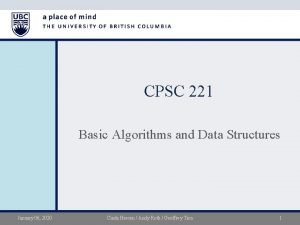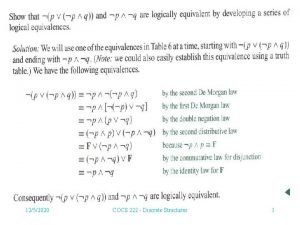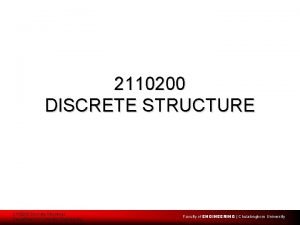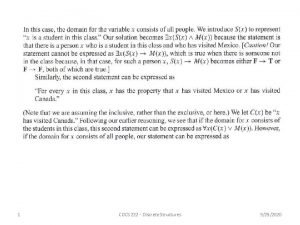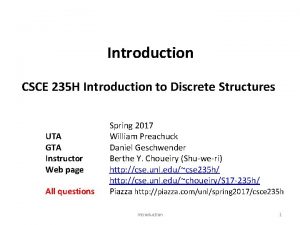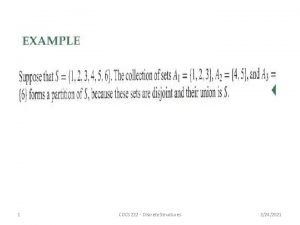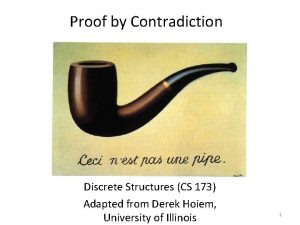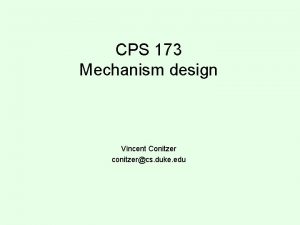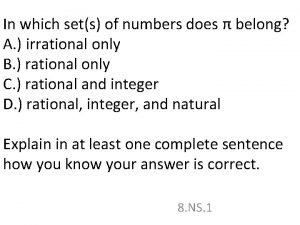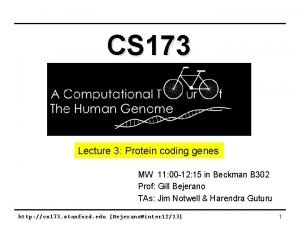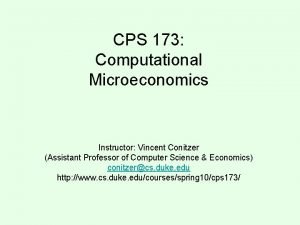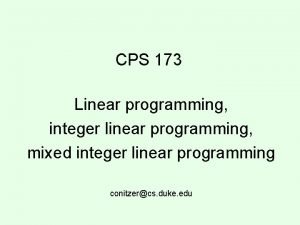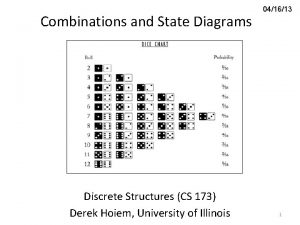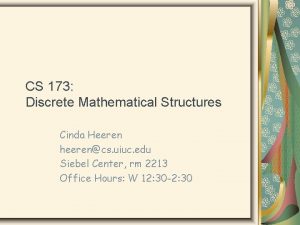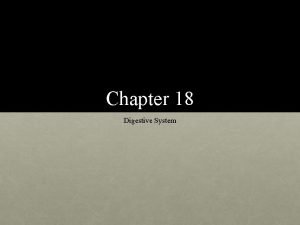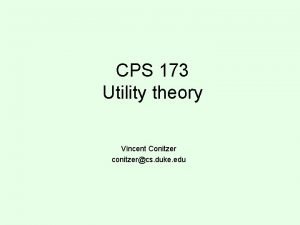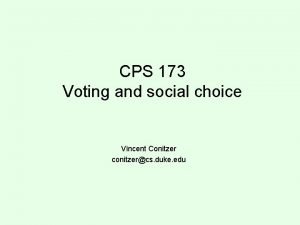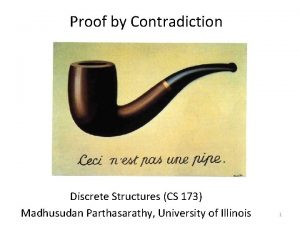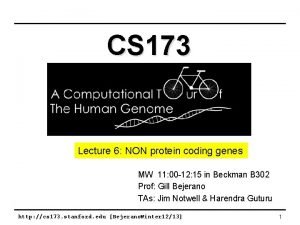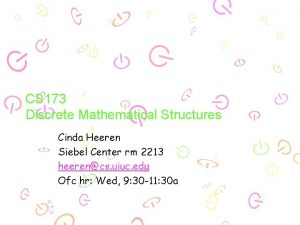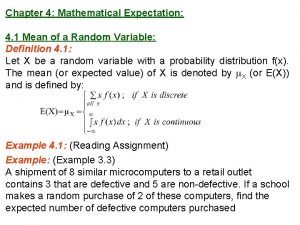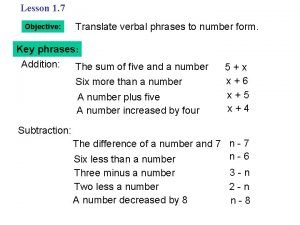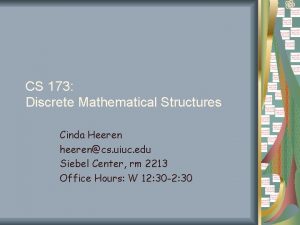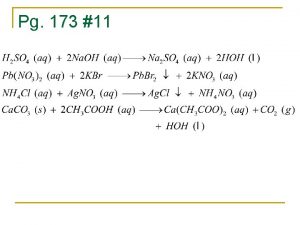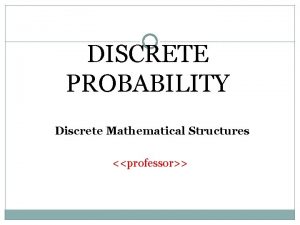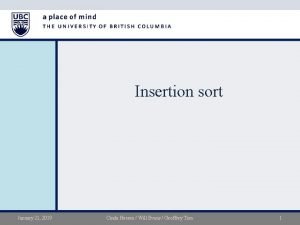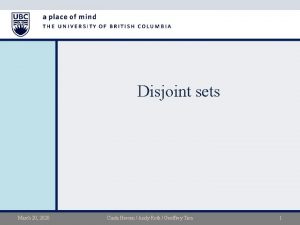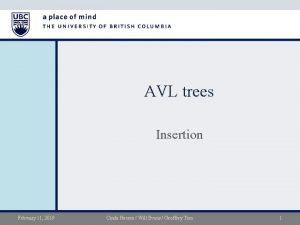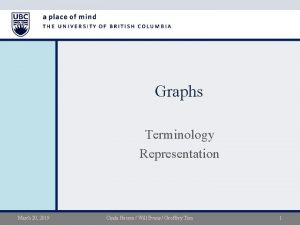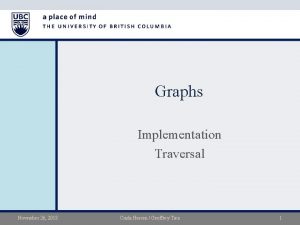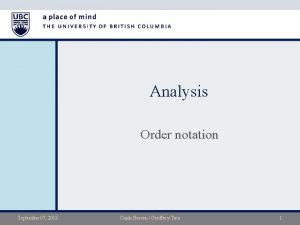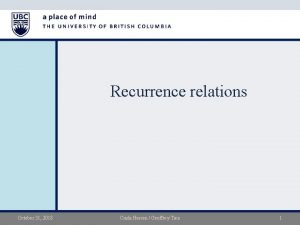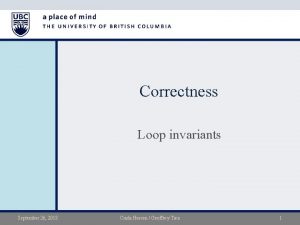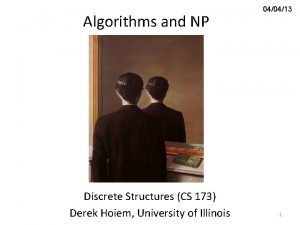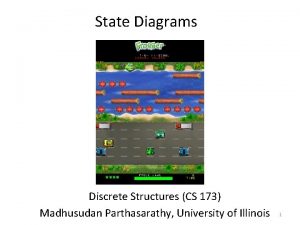CS 173 Discrete Mathematical Structures Cinda Heeren heerencs










![CS 173 Equivalence Classes What equivalence relation we’ve seen recently has representatives [244], [7], CS 173 Equivalence Classes What equivalence relation we’ve seen recently has representatives [244], [7],](https://slidetodoc.com/presentation_image_h2/7c844cd696b4d444d0064a31039b4fbc/image-11.jpg)





![CS 173 Equivalence Classes Theorem: if R is a _____ S, then {[a]R : CS 173 Equivalence Classes Theorem: if R is a _____ S, then {[a]R :](https://slidetodoc.com/presentation_image_h2/7c844cd696b4d444d0064a31039b4fbc/image-17.jpg)
























- Slides: 41

CS 173: Discrete Mathematical Structures Cinda Heeren heeren@cs. uiuc. edu Siebel Center, rm 2213 Office Hours: W 12: 30 -2: 30

CS 173 Announcements Homework #11 available, due 12/04, 8 a. Final exam 12/14, 8 -11 a. Email Cinda with conflicts. Exam 2 returned in section. If you have no section, see me. Exam 2 avg: 58, so I’m giving you 15% on the exam, or 3 class points. Cs 173 - Spring 2004

CS 173 Transitive Closure Let c(R ) denote the transitive closure of relation R. Then c(R ) = R U { (a, c): b (a, b), (b, c) R } Example: A={1, 2, 3, 4}, R={(1, 2), (2, 3), (3, 4)}. Apply definition to get: c(R ) = {(1, 2), (2, 3), (3, 4), } (1, 3), (2, 4) Which of the following is true: a) This set is transitive, but we added too much. b) This set is the transitive closure of R. c) This set is not transitive, one pair is missing. d) This set is not. Cs 173 transitive, more than 1 pair is - Spring 2004 missing.

CS 173 Transitive Closure So how DO we find the transitive closure? Draw a graph. Example: A={1, 2, 3, 4}, R={(1, 2), (2, 3), (3, 4)}. 1 4 2 3 Define a path in a relation R, on A to be a sequence of elements from A: a, x 1, …xi, …xn-1, b, with (a, x 1) R, i (xi, xi+1) R, (xn-1, b) R. Cs 173 - Spring 2004 “Path from a to b. ”

CS 173 Transitive Closure Formally: If t(R) is the transitive closure of R, and if R contains a path from a to b, then (a, b) t(R) Notes: Later classes will give you efficient algorithms for determining if there is a path between two vertices in a graph (graph connectivity problem) Read about Warshall’s algorithm in the text. Cs 173 - Spring 2004

CS 173 Equivalence Relations Example: Let S = {people in this classroom}, and let R = {(a, b): a has same # of coins in his/her bag as b} Quiz time: Is R reflexive? Is R symmetric? Is R transitive? Yes Yes This is a special kind of relation, characterized by the properties it has. Everyone with the same # What’s special of coins as about it? you is just like you. Cs 173 - Spring 2004

CS 173 Equivalence Relations Formally: Relation R on A is an equivalence relation if R is Reflexive ( a A, a. Ra) “What the Symmetric (a. Rb --> b. Ra) heck is a. Rb? ” Transitive (a. Rb ^ b. Rc --> a. Rc) a. Rb denotes (a, b) R. Example: S = Z (integers), R = {(a, b) : a b mod 4} a%4 = b? Is this relation an equivalence relation on S? Have to PROVE reflexive, symmetric, transitive. Cs 173 - Spring 2004

CS 173 Equivalence Relations Example: S = Z (integers), R = {(a, b) : a b mod 4} Is this relation an equivalence relation on S? Start by thinking of R a different way: a. Rb iff there is an int k so that a = 4 k + b. Your quest becomes one of finding ks. Let a be any integer. a. Ra since a = 4 0 + a. Consider a. Rb. Then a = 4 k + b. But b = -4 k + a. Consider a. Rb and b. Rc. Then a = 4 k + b and b = 4 j + c. So, a = 4 k + 4 j +c = 4(k+j) + c. Cs 173 - Spring 2004

CS 173 Equivalence Relations Example: S = people in this room, R = {(a, b) : total $ on a is within $1. 00 of total $ on b} Is this relation an equivalence relation on S? Clearly reflexive and symmetric. Is it transitive? a) b) c) d) Yes, I can give a proof. Yes, I think so, but I can’t prove it. No, I can give a proof. No, I don’t think so, but I can’t prove it. Cs 173 - Spring 2004

CS 173 Equivalence Classes Example: Back to coins in bags. Definition: Let R be an equivalence relation on S. The equivalence class of a S, [a]R, is [a]R = {b: a. Rb} a is just a name for the equiv class. Any member of the class is a representative. Cs 173 - Spring 2004
![CS 173 Equivalence Classes What equivalence relation weve seen recently has representatives 244 7 CS 173 Equivalence Classes What equivalence relation we’ve seen recently has representatives [244], [7],](https://slidetodoc.com/presentation_image_h2/7c844cd696b4d444d0064a31039b4fbc/image-11.jpg)
CS 173 Equivalence Classes What equivalence relation we’ve seen recently has representatives [244], [7], [58], [1]? Cs 173 - Spring 2004

CS 173 Equivalence Classes Definition: Let R be an equivalence relation on S. The equivalence class of a S, [a]R, is [a]R = {b: a. Rb} Notice this is just a subset of S. What does the set of equivalence classes on S look like? To answer, think about the relation from before: S = {people in this room} R = {(a, b) : a has the same # of coins in his/her bag as b} In how many different equivalence classes can each person fall? Cs 173 - Spring 2004

CS 173 Equivalence Classes Lemma: Let R be an equivalence relation on S. Then If a. Rb, then [a]R = [b]R 2. If not a. Rb, then [a]R [b]R = 1. Proof: 1. Suppose a. Rb, and consider x S. x [a]R a. Rx Defn of [a]R x. Ra symmetry x. Rb transitivity b. Rx x [b]R symmetry Defn of [b]R Cs 173 - Spring 2004

CS 173 Equivalence Classes Lemma: Let R be an equivalence relation on S. Then If a. Rb, then [a]R = [b]R 2. If not a. Rb, then [a]R [b]R = 1. Proof: 2. Suppose to the contrary that x [a]R [b]R. x [a]R x [b]R a. Rx and b. Rx a. Rx and x. Rb a. Rb, contradicting “not a. Rb” Thus, [a]R and [b]R are either identical or disjoint. Cs 173 - Spring 2004

CS 173 Equivalence Classes So S is the union of disjoint equivalence classes of R. A partition of a set S is a (perhaps infinite…or uncountably infinite) collection of sets {Ai} with Each Ai non-empty Each Ai S For all i, j, Ai Aj = S = Ai Cs 173 - Spring 2004 Each Ai is called a block of the partition.

CS 173 Equivalence Classes Give me a partition of the reals into 2 blocks: Give me a partition of the reals into 5 blocks: Cs 173 - Spring 2004
![CS 173 Equivalence Classes Theorem if R is a S then aR CS 173 Equivalence Classes Theorem: if R is a _____ S, then {[a]R :](https://slidetodoc.com/presentation_image_h2/7c844cd696b4d444d0064a31039b4fbc/image-17.jpg)
CS 173 Equivalence Classes Theorem: if R is a _____ S, then {[a]R : a S} is a _____ S. A. B. C. D. E. Partition of, equivalence relation on Subset of, equivalence class of Relation on, partition of Equivalence relation on, partition of I have no clue. Theorem: if R is an equivalence relation on S, then {[a] R : a S} is a partition of S. Proof: we need to show that an equivalence relation R satisfies the definition of a partition. (we’ve spent the whole day doing this!) Cs 173 - Spring 2004

CS 173 Equivalence Classes Theorem: if {Ai} is any partition of S, then there exists an equivalence relation R, whose equivalence classes are exactly the blocks Ai. Proof If {Ai} partitions S then define relation R on S to be R = {(a, b) : i, a Ai and b Ai} Next show that R is an equivalence relation. Reflexive and symmetric. Transitive? Suppose a. Rb and b. Rc. Then a and b are in Ai, and b and c are in Aj. But b Ai Aj, so Ai = Aj. So, a, b, c Ai, thus a. Rc. Cs 173 - Spring 2004

CS 173 Partially Ordered Sets (POSets) Let R be a relation then R is a Partially Ordered Set (POSet) if it is • Reflexive - a. Ra, a • Transitive - a. Rb b. Rc a. Rc, a, b, c • Antisymmetric - a. Rb b. Ra a=b, a, b Ex. (R, ), the relation “ ” on the real numbers, is a partial order. = Reflexive? a a for any real How do you check? order Transitive? If a b, b c then a c Actually total order. < Antisymmetric? If a b, b a then a = b Cs 173 - Spring 2004

CS 173 Partially Ordered Sets (POSets) Ex. (Z+, | ), the relation “divides” on positive integers. Reflexive? Transitive? Yes, or No? Yes, x|x since x=1 x (k=1) a|b means b=ak, b|c means c=bj. Does c=am for some m? c = bj = akj (m=kj) Antisymmetric? a|b means b=ak, b|a means a=bj. But b = bjk (subst) only if jk=1 means j=k=1, and we have b=a 1, or b=a Cs 173 - Spring 2004

CS 173 Partially Ordered Sets (POSets) Ex. (Z, | ), the relation “divides” on integers. Reflexive? Transitive? Yes, x|x since x=1 x (k=1) a|b means b=ak, b|c means c=bj. Does c=am for some m? c = bj = akj (m=kj) Antisymmetric? Not a poset. 3|-3, and -3|3, but 3 -3. Yes, or No? Cs 173 - Spring 2004

CS 173 Partially Ordered Sets (POSets) A poset. Ex. (2 S, ), the relation “subset” on set of all subsets of S. Reflexive? Transitive? Yes, A A, A 2 S A B, B C. Does that mean A C? A B means x A x B B C means x B x C A. Modus Ponens B. Now take an x, and suppose it’s in A. Must it also be in C? Modus Tollens C. De. Morgan’s Antisymmetric? D. Transitivity A B, B A A=B Cs 173 - Spring 2004 Yes, by… by MP

CS 173 Partially Ordered Sets (POSets) When we don’t have a special relation definition in mind, we use the symbol “ ” to denote a partial order on a set. When we know we’re talking about a partial order, we’ll write “a b” instead of “a. Rb” when discussing members of the relation. We will also write “a < b” if a b and a b. Cs 173 - Spring 2004

CS 173 Partially Ordered Sets (POSets) A. 0110 1000 B. 0110 0000 Ex. A common partial order on bit strings of length n, C. 0110 1110 {0, 1}n, is defined as: a 1 a 2…an b 1 b 2…bn D. 0110 10111 If and only if ai bi, i. 0110 and 1000 are “incomparable” … We can’t tell which is “bigger. ” As a bit of an aside, this relation is exactly the same as the last example, (2 S, ). Huh? Set S, on which we build 2 S, has a size. That’s n. Suppose S is {a, b}. Then 2 S = { {}, {a}, {b}, {a, b} } Think of bit strings as membership indicators for the elts of S Then 2 S can be represented by- Spring {00, 10, 01, 11} Cs 173 2004

CS 173 Partially Ordered Sets (POSets) 0110 and 1000 are “incomparable” … We can’t tell which is “bigger. ” As a bit of an aside, this relation is exactly the same as the last example, (2 S, ). Set S, on which we build 2 S, has a size. That’s n. Suppose S is {a, b}. Then 2 S = { {}, {a}, {b}, {a, b} } Think of bit strings as membership indicators for the elts of S Then 2 S can be represented by {00, 10, 01, 11} In the string relation, we said 00 01 because every bit in 00 is less than or = the corresp bit in 01. String on the right has at least all the 1 bits of the left, maybe more. If each 1 represents an element in S, then right side. Cs 173 has all elts of the left, maybe more. - Spring 2004

CS 173 Partially Ordered Sets (POSets) Let (S, ) be a PO. If a b, or b a, then a and b are comparable. Otherwise, they are incomparable. Ex. In poset (Z+, |), 3 and 6 are comparable, 6 and 3 are comparable, 3 and 5 are not, 8 and 12 are not. A total order is a partial order where every pair of elements is comparable. Ex. (Z+, ), is a total order, because for every pair (a, b) in Zx. Z, either a b, or b a. Cs 173 - Spring 2004 Dictionary order, or alphabetic order, or lexicographic order is a partial order on words in the english language. This idea can be generalized to strings over any alphabet.

CS 173 Hasse Diagrams Hasse diagrams are a special kind of graphs used to describe posets. Ex. In poset ({1, 2, 3, 4}, ), we can draw the following picture to describe the relation. 4 3 2 1 b 1. Draw edge (a, b) if a 2. Don’t draw up arrows 3. Don’t draw self loops 4. Don’t draw transitive edges Cs 173 - Spring 2004

CS 173 Hasse Diagrams Have you seen this one before? {a, b, c} or 111 {a, b} or 110 {a, c} or 101 {b, c} or 011 {a} or 100 {b} or 010 {c} or 001 {} or 000 Cs 173 - Spring 2004

CS 173 Hasse Diagrams Consider this poset: Reds are maximal. Blues are minimal. Cs 173 - Spring 2004

CS 173 Hasse Diagrams Definition: In a poset S, an element z is a minimum element if b S, z b. Intuition: If a is maxi. MAL, then no one beats a. If a is maxi. MUM, a beats everything. Write the defn of maximum! Did you get it right? Must minimum and maximum exist? A. Only if set is finite. B. No. C. Only if set is transitive. D. Yes. Cs 173 - Spring 2004

CS 173 Hasse Diagrams Theorem: In every poset, if the maximum element exists, it is unique. Similarly for minimum. Proof: Suppose there are two maximum elements, a 1 and a 2, with a 1 a 2. Then a 1 a 2, and a 2 a 1, by defn of maximum. So a 1=a 2, a contradiction. Thus, our supposition was incorrect, and the maximum element, if it exists, is unique. Similar proof for minimum. Cs 173 - Spring 2004

CS 173 Upper and Lower Bounds Defn: Let (S, ) be a partial order. If A S, then an upper bound for A is any element x S (perhaps in A also) such that a A, a x. A lower bound for A is any x S such that a A, a x. a c g b Ex. The upper bound of {g, j} is a. Why not b? d e f h i j Cs 173 - Spring 2004

CS 173 Upper and Lower Bounds Defn: Let (S, ) be a partial order. If A S, then an upper bound for A is any element x S (perhaps in A also) such that a A, a x. A lower bound for A is any x S such that a A, a x. a c g b d e f h i j Ex. The upper bound of {g, j} is a. Why not b? Ex. The upper bounds of {g, i} is/are… A. I have no clue. B. c and e {a, b} has no C. a UB. D. a, c, and e Cs 173 - Spring 2004

CS 173 Upper and Lower Bounds Defn: Let (S, ) be a partial order. If A S, then an upper bound for A is any element x S (perhaps in A also) such that a A, a x. A lower bound for A is any x S such that a A, a x. a c g b d e f h i j Ex. The lower bounds of {a, b} are d, f, i, and j. Ex. The lower bounds of {c, d} is/are… A. I have no clue. B. f, i {g, h, i, j} C. j, i, g, h has no LB. D. e, f, j Cs 173 - Spring 2004

CS 173 Upper and Lower Bounds Defn: Given poset (S, ) and A S, x S is a least upper bound (LUB) for A if x is an upper bound and for upper bound y of A, y x. x is a greatest lower bound for A if x is a lower bound and if x y for every UB y of A. a c g b d e f h i j Ex. LUB of {i, j} = d. Ex. GLB of {g, j} is… A. I have no clue. B. a C. non-existent D. e, f, j Cs 173 - Spring 2004

CS 173 Upper and Lower Bounds Ex. In the following poset, c and d are lower bounds for {a, b}, but there is no GLB. Similarly, a and b are upper bounds for {c, d}, but there is no LUB. a b c d Cs 173 - Spring 2004 This is because c and d are incomparable.

CS 173 Total Orders Consider the problem of getting dressed. Precedence constraints are modeled by a poset in which a b iff you must put on a before b. shoes socks belt jacket jeans swter uwear shirt jwlry In what order will you get dressed while respecting constraints? Let (S, ) be a poset (S finite). We will extend to a total order on S, so we can decide for all incomparable pairs Spring 2004 whether to make a b, Cs 173 or -vice versa w/o violating T, R, A.

CS 173 Total Orders Things we need: Lemma: Every finite non-empty poset (S, ) has at least one minimal element. shoes socks belt jacket jeans swter uwear shirt jwlry NOT A REAL PROOF! Should use induction!! Proof: choose a 0 S. If a 0 was not minimal, then there exists a 1 a 0, and so on until a minimal element is found. Cs 173 - Spring 2004

CS 173 Total Orders More things we need: Lemma: If (S, ) is a poset with a minimal, then (S-{a}, ) is also a poset. shoes socks belt jacket jeans swter uwear shirt jwlry Proof: If you remove minimal a reflexivity and antisymmetry still hold. If x, y, z S-{a}, with x y and y z, then x z Cs 173 - Spring 2004 too, since (S, ) was transitive.

CS 173 Total Orders Think about what this means: 1. There is always a minimal element. 2. If you remove it you still have a poset. shoes socks belt jeans Depending on which min elt is chosen each time, uwear a different total order is obtained, but all TOs will be consistent with the PO. jacket swter jwlry alg Topological Sort Input: poset (S, ) shirt Out: elements of S in total order This suggests: While S Remove any min elt from S and output it. Cs 173 - Spring 2004

CS 173 Total Orders jacket shoes socks belt swter jeans shirt uwear t Cs 173 - Spring 2004 alg Topological Sort Input: poset (S, ) Out: elements of S in total order While S Remove any min elt from S and output it. jwlry
 Geoffrey tien ubc
Geoffrey tien ubc Asaf kanari
Asaf kanari Econ213
Econ213 Discrete computational structures
Discrete computational structures Absorption law
Absorption law Discrete structures
Discrete structures Discrete structures
Discrete structures Discrete structures
Discrete structures Webhandin unl
Webhandin unl Discrete structures
Discrete structures Homologous structures examples
Homologous structures examples Cps 173
Cps 173 Cs 173
Cs 173 Cps 173
Cps 173 What set or sets of numbers does 450 belong?
What set or sets of numbers does 450 belong? Cs 173
Cs 173 Cps 173
Cps 173 Cps 173
Cps 173 Cs 173
Cs 173 Rasm asosida matn tuzing
Rasm asosida matn tuzing Logo smpn 173 jakarta
Logo smpn 173 jakarta Art 119 lottt
Art 119 lottt Cs173 uiuc
Cs173 uiuc Digestive
Digestive Vincent conitzer
Vincent conitzer Cps 173
Cps 173 173-mashq
173-mashq Fluke 173
Fluke 173 574-173-443
574-173-443 Cps 173
Cps 173 Akta 173 uitm
Akta 173 uitm Cps 173
Cps 173 Cs 173
Cs 173 Cs 173
Cs 173 Uiuc cs 173
Uiuc cs 173 Art 173 tuir
Art 173 tuir Mathematical problems
Mathematical problems Vdoe math rich tasks
Vdoe math rich tasks Schedule ng supply
Schedule ng supply Var(x)=
Var(x)= Mathematical induction
Mathematical induction The verbal phrase of the inequality symbol greater than
The verbal phrase of the inequality symbol greater than
